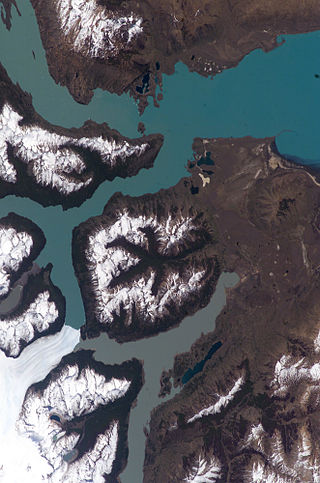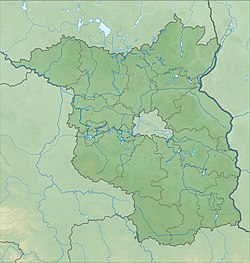
The Camarillas Formation is a geological formation in the Teruel Province of Aragón, Spain whose strata date back to the Early Cretaceous. The sandstones, mudstones and conglomerates of the formation, that due to syn-sedimentary faulting varies greatly in thickness from 300 to 800 metres, were deposited in fluvial, deltaic and lacustrine environments.

The Chorrillo Formation, also named as Chorillo Formation, is a Maastrichtian geologic formation in southern Patagonia, Argentina. The formation is more than 50 metres (160 ft) thick and underlies the Calafate Formation and rests on top of the La Irene Formation.

The Speeton Clay Formation (SpC) is a Lower Cretaceous geological formation in Yorkshire, northern England. Unlike the contemporaneous terrestrial Wealden Group to the south, the Speeton Clay was deposited in marine conditions. The most common fossils in the unit are belemnites, followed by ammonites and the lobster Meyeria ornata. Dinosaur remains are among the fossils that have been recovered from the formation, although none have yet been referred to a specific genus.
The Tiki Formation is a Late Triassic geologic formation in Madhya Pradesh, northern India. Dinosaur remains are among the fossils that have been recovered from the formation, although none have yet been referred to a specific genus. Phytosaur remains attributable to the genus Volcanosuchus have also been found in the Tiki Formation.
The Severn Formation is a Mesozoic geologic formation in Maryland. Dinosaur remains diagnostic to the genus level are among the fossils that have been recovered from the formation.

Fordilla is an extinct genus of early bivalves, one of two genera in the extinct family Fordillidae. The genus is known solely from Early Cambrian fossils found in North America, Greenland, Europe, the Middle East, and Asia. The genus currently contains three described species, Fordilla germanica, Fordilla sibirica, and the type species Fordilla troyensis.
The Jobu Formation is a Cretaceous geologic formation of Late Cenomanian age. Dinosaur remains are among the fossils that have been recovered from the formation, although none have yet been referred to a specific genus. The oldest confirmed tyrannosaurid premaxillary tooth was recovered from the Jobu Formation. The mammal Sorlestes is also known from the formation.
Pojetaia is an extinct genus of early bivalves, one of two genera in the extinct family Fordillidae. The genus is known solely from Early to Middle Cambrian fossils found in North America, Greenland, Europe, North Africa, Asia, and Australia. The genus currently contains two accepted species, Pojetaia runnegari, the type species, and Pojetaia sarhroensis, though up to seven species have been proposed. The genera Buluniella, Jellia, and Oryzoconcha are all considered synonyms of Pojetaia.
Tuarangia is a Cambrian shelly fossil interpreted as an early bivalve, though alternative classifications have been proposed and its systematic position remains controversial. It is the only genus in the extinct family Tuarangiidae and order Tuarangiida. The genus is known solely from Middle to Late Cambrian fossils found in Europe and New Zealand. The genus currently contains two accepted species, Tuarangia gravgaerdensis and the type species Tuarangia paparua.

The Wasatch Formation (Tw) is an extensive highly fossiliferous geologic formation stretching across several basins in Idaho, Montana Wyoming, Utah and western Colorado. It preserves fossils dating back to the Early Eocene period. The formation defines the Wasatchian or Lostcabinian, a period of time used within the NALMA classification, but the formation ranges in age from the Clarkforkian to Bridgerian.

The Mint Canyon Formation (Tm) is a Miocene geologic formation in the Sierra Pelona Mountains of Los Angeles County, southern California. The formation preserves fossils dating back to the Middle to Late Miocene.
The Flume Formation is a geologic formation in the Western Canada Sedimentary Basin in Alberta, Canada. It was deposited as an extensive carbonate platform along the western edge of the basin during Late Devonian (Frasnian) time and the reefs of the Cairn Formation subsequently developed on it.
The Coldwater Beds are a geologic formation of the Okanagan Highlands in British Columbia, Canada. They preserve fossils dating back to the Ypresian stage of the Eocene period, or Wasatchian in the NALMA classification.
The Las Tetas de Cabra Formation is a geologic formation in Mexico. It preserves fossils dating back to the Wasatchian of the Early Eocene period.
The Marne de Flize is a geologic formation in France. It preserves fossils dating back to the Toarcian stage of the Jurassic period.
The Argiles d'lignite du Soissonnais is a geologic formation in the Oise department of northern France. The formation has provided fossil mammals, reptiles and fish as well as arthropods in the amber of the formation. The Argiles d'lignite du Soissonnais dates back to the Ypresian stage of the Eocene period.
The Painten Formation is a geologic formation in Germany. It preserves fossils dating back to the Tithonian stage of the Late Jurassic period.
The El Molino Formation is a Maastrichtian geologic formation pertaining to the Puca Group of central Bolivia. The formation comprises fine-grained sandstones and sandy limestones with stromatolites deposited in a shallow marine to lacustrine environment. The formation has provided fossils of Dolichochampsa minima, and ichnofossils of Ankylosauria indet., Ornithopoda indet., Theropoda indet. and Titanosauridae indet. The tracksite of Cal Orcko is the best known example of the ichnofossil locations of the formation. The ichnofossil of Ligabueichnum bolivianum may be attributed to an ankylosaur. The fossil fish species Dasyatis molinoensis is named after the formation.
The Silveirinha Formation is an Early Eocene geologic formation of the Mondego Basin in the Região Centro of central-western Portugal. The sandstones, siltstones and conglomerates were deposited in an alluvial environment.
The Melbourne Formation is a geologic formation in Victoria, Australia. It preserves fossils dating back to the Ludlow epoch of the Silurian period.







